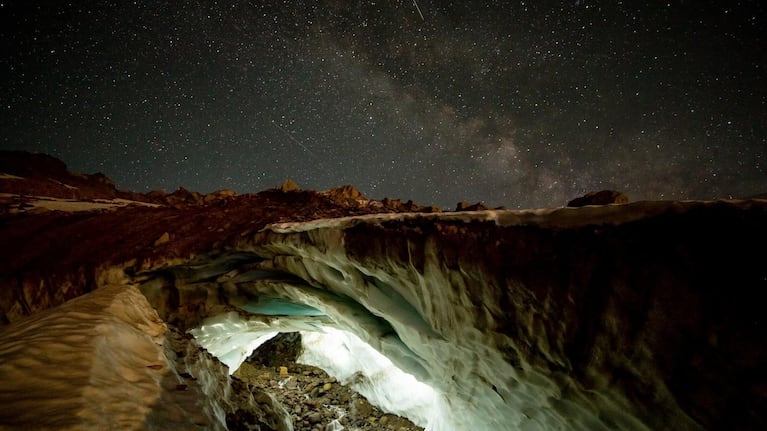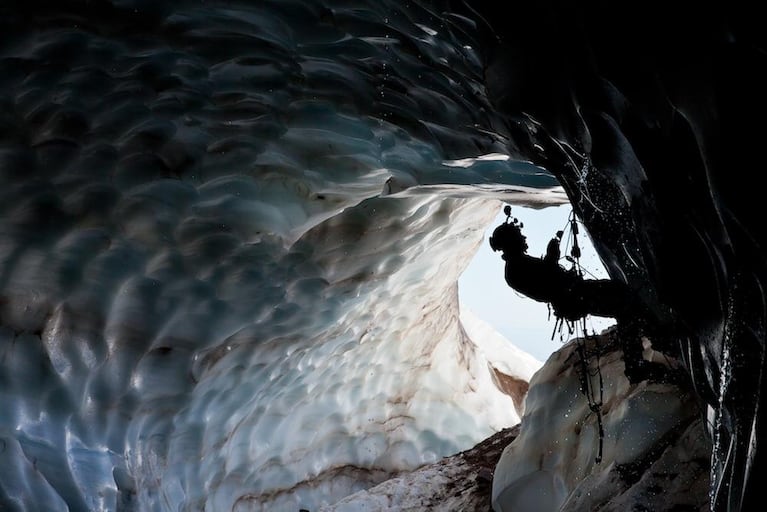
A starry night above the moulin on Mount Hood's Sandy Glacier. The Moulin drains the glacier and opens to a secret - and fast-expanding - world of tunnels and caves.
Andy Maser
On the slopes of Mount Hood, six explorers set off in a line up the Sandy Glacier.
Eddy Cartaya pulls ahead of the group, a stony expression on his face.
He’s wearing a white helmet with his name and “Cave Rescue” printed on it. Cartaya is worried because the sun is starting to rise and hit the ice.
His climbing partner Brent McGregor follows at a more reasonable pace. The bearded 60-year-old takes in the morning and smiles.
“One of the best sounds in alpine mountaineering is the sound of crampons and ice axes on good firm snow,” he says.
Experience THIN ICE
Check out OPB's full digital version of THIN ICE. opb.org/glaciercaves
Tune in Thursday, Oct. 10 at 8:30 p.m. to watch 'Glacier Caves: Mount Hood's Secret World' on OPB TV's Oregon Field Guide.
The Sandy Glacier flows down a steep bowl about two-thirds of the way up Mount Hood’s northwest side. You can see it from Portland; a wedge of snow and ice between two broken ridgelines that rise toward Hood’s 11,250-foot peak.
The team isn’t interested in the summit. McGregor and Cartaya are leading their expedition to a gaping hole in the glacier. It’s a moulin: an icy pit that drops like an elevator shaft from the surface of the Sandy Glacier down to the bedrock below.
McGregor (L) and Cartaya prepare to enter the moulin. Credit: Katie Campbell
Like Alice’s rabbit hole, the moulin is a portal to another world. It leads into an ice cave that McGregor discovered underneath the glacier in 2011.
Since then, McGregor and Cartaya have mapped more than a mile of caves and tunnels beneath the Sandy.
The explorers suspect the beautiful formations account for a significant loss of the glacier’s ice, and they have set out to measure how much these openings are increasing in size each year.
It’s an unconventional mission. Climate scientists and glaciologists have tracked the melting of more than 200 glaciers around the world, but they’ve almost always gathered their data from the surface. Taking measurements from within a glacier? That’s a new scientific frontier.
Listen to the radio report
In addition to their climbing gear, the team carries survey tools. At the mouth of the moulin, they build anchors in the snow and begin fixing ropes.
“ROCK!” someone calls out.
Everyone wheels around. A rock the size of a baseball rolls down the slope past the group. A harmless event, but a reminder that a rock could easily tumble into the moulin and kill a person standing at the bottom.
McGregor ropes up and walks to the edge of the pit.
“Going down in, it humbles you. You’re like a little ant in there,” he says.
Cavers rappel down into the moulin. Credit: Andy Maser
Radio communication is impossible under the ice, so Cartaya strings a Norwegian military phone line, known as a cricket phone for the chirping it makes, down into the moulin. McGregor will let the team know whether the cave is safe to enter.
McGregor begins to descend. In places, melting has exposed boulders that rolled on to the ice hundreds of years ago and were incorporated into the glacier. They perch precariously above his head.
He drops out of sight.
A few minutes later, the phone chirps. The team can barely hear McGregor over the sound of rushing water.
“You can come down. And it’s unfriggin’ believable,” they hear him say. “It’s changed tremendously. You won’t even recognize it.”
A World Beneath The Ice
McGregor and Cartaya have identified three distinct caves in the Sandy Glacier and named them Snow Dragon, Pure Imagination and Frozen Minotaur. The combined 7,000 feet of passages reach like fingers of a hand beneath the ice.
Watch the animation
Credit: Oregon Field Guide
They may comprise the longest glacial cave system discovered in the U.S. outside of Alaska, according to experts.
One of them is Jason Gulley, a glaciologist at Michigan Technological University.
Gulley says it’s hard to say for sure because few people have the skills - or the inclination - to explore a glacier’s plumbing system. Gulley is one of the few. He crawled deep inside glacial caves in Nepal, Alaska, and Svalbard during his field studies.
“There’s really only three or four people in the U.S. that are managing glacier cave exploration,” Gulley says. “You have to have all the caving skills to negotiate the caves, but you have to have the mountaineering skills to get there.”
Moulins and caves are normal features in glaciers. They function as the drainage system for these rivers of ice. Normally, conduits form when temperatures rise and melt water flows down through cracks in the ice. They collapse when the melt season ends. It’s an annual cycle.
Large, permanent caves like those on the Sandy only form when a glacier is thin and the weight of the ice no longer squeezes the caves shut, allowing warm air to flow into the glacier.
The Artist And The Ice Climber
McGregor and Cartaya have drawn on years of experience mountaineering and caving to safely explore the caves in the Sandy Glacier.
Their personalities complement each other. McGregor is a free-spirited photographer, mountaineer, and woodworker; Cartaya, 44, is is a Type A law enforcement officer for the U.S. Forest Service and an ice climber with search-and-rescue experience.
Brent McGregor. Credit: Katie Campbell
As a teenager, McGregor bought a canoe and decided to paddle it the length of the Canadian coast to Alaska. Later, he took up logging and woodworking and spent four years hand-building a cabin in Wyoming— and all the furniture inside. (Link to Art Beat Episode #626).
McGregor started mountaineering in his 40s, summiting the Cascade volcanoes from Shasta to Rainier. He once spent a night on Mount Jefferson after breaking a leg on his way down from the summit. He says he struggled to find a caving and mountaineering partner who was as adventuresome as he was.
“Not that I had a death wish, but I was very curious about things out in the natural world and wanted to see what was there,” he says.
Even Cartaya’s closest friends speak about him with a kind of awe. He attended West Point, plays the piano, and spends much of his free time volunteering with Deschutes County Search and Rescue.
Cartaya moved to Oregon from North Carolina, where he worked for the National Park Service. A skilled rock- and ice-climber, he used to free solo, or climb without safety gear.
Then his climbing partner died in an accident on waterfall ice in 2010.
Eddy Cartaya. Credit: Katie Campbell
“It brought the risks more into focus,” Cartaya says. “I used to climb without ropes on ice and rock. Now I’ve stopped doing that.’
A few months later, U.S. Forest Service hired Cartaya as a law enforcement officer and manager for the hundreds of caves in Central Oregon’s Deschutes National Forest.
One of his first jobs in Oregon was a 60-year-old cold case involving rare rock formations that had been stolen from a lava tube. It was McGregor, the head of the local caving association, who brought him the case. Cartaya tracked down the missing lavacicles.
The two clicked immediately and began caving and climbing together. It wasn’t long before McGregor shared with Cartaya his dream of finding a glacier cave.
The Way In
Over the years, McGregor searched 17 glaciers in Oregon without any luck, rappelling into crevasses and marveling at the snow formations inside. Then in 2011 he found a
of people inside a cave in the Sandy Glacier.
A thick blanket of fog covered the glacier the weekend he and Cartaya went looking for it. The men spent a day searching for the entrance and found nothing. On the second day, McGregor spotted a deep crack in the ice.
“As soon as he shimmied his way through, you could hear whooping and hollering, going crazy in there,” Cartaya says.
Thin ice in the caves appears blue-green. Credit: Brent McGregor
The cave on the other side of the crack was large enough to fit an orchestra inside and stretched deep into the glacier. Its white walls were scalloped, as if someone had been sculpting the ice with a giant ice cream scoop. McGregor and Cartaya named it Snow Dragon.
Cartaya had discovered a handful of limestone caves back east. McGregor had helped discover new lava tubes in Oregon.
But they’d never found anything like this before. The cave sucked them in, not only because it of its unique beauty, but because the ice was constantly changing.
“Here’s a place that you don’t just discover once,” Cartaya says. “You can discover it again and again.”
Cave Fever
The prospect of exploring a passage that no human has ever seen before turns serious cavers a little crazy.
“They’ll quit work, not go home for days, do whatever they need to do to get there, be the first one to experience it, and document it,” Cartaya says.
It's called cave fever, or just the fever.
After McGregor and Cartaya saw Snow Dragon, they developed a bad case of the fever. They combed the glacier for more caves. Late in the summer, McGregor wiggled through a small hole in the ice and found a wide passage arched like a railroad tunnel that led him deep inside the glacier. A waterfall forced him to turn around before he reached the end. He named the second cave Pure Imagination.
Inside Snow Dragon. Credit: Brent McGregor
After that, McGregor and Cartaya discovered the moulin together. They named it Cerberus after the three-headed dog that guards the gates to the underworld of Greek mythology.
They kept exploring through the dead of winter. Cartaya remembers thinking that even a minor injury like a sprained ankle could have left one of them dead from hypothermia.
“We didn’t have any communication for help,” he says, “and we’re inside a place that nobody even knows exists.” On a trip in January, they slept inside Snow Dragon to take shelter from a fierce storm.
They found a third cave, named Frozen Minotaur, a maze of unstable tunnels filled with rolling rocks and frigid whitewater. They hauled in scuba gear to explore it. At one point, McGregor’s wetsuit came unzipped and immediately inflated with freezing water “like the Michelin Man,” he says. He thought for a moment his heart had stopped. Cartaya dried him out and warmed him up.
Glacier Caving Caution
When Brent McGregor and Eddy Cartaya explore the Sandy Glacier they follow safety protocols, including signing into cave register and staying in radio communication with local search and rescue teams.
Glacier cave exploration requires preparation for serious hazards:
Each return to the changing ice world brought a new rush of adrenaline for Cartaya, a new natural sculpture for McGregor to photograph. But adventure and discovery didn’t satisfy them.
They felt there was more to to be learned from the world they had found. They collected feathers and seeds that dropped out of the ice and watched the rivers inside the glacier change course.
In particular, as they watched the caves grow, they suspected that the openings were causing the glacier to melt and retreat faster.
Tomorrow: Cave exploration and climate change discovery.







